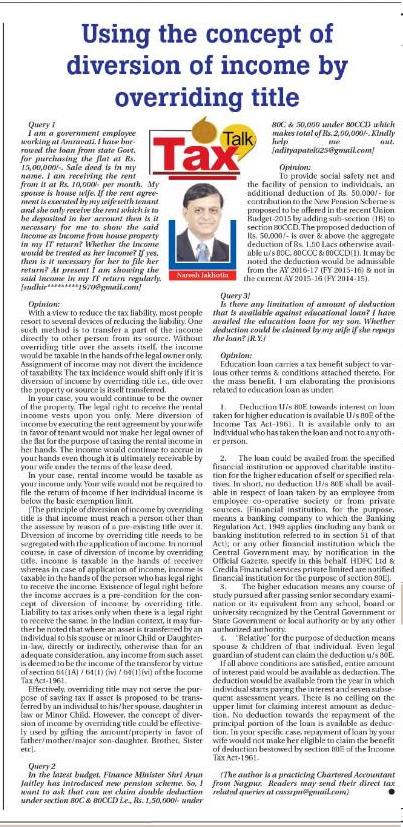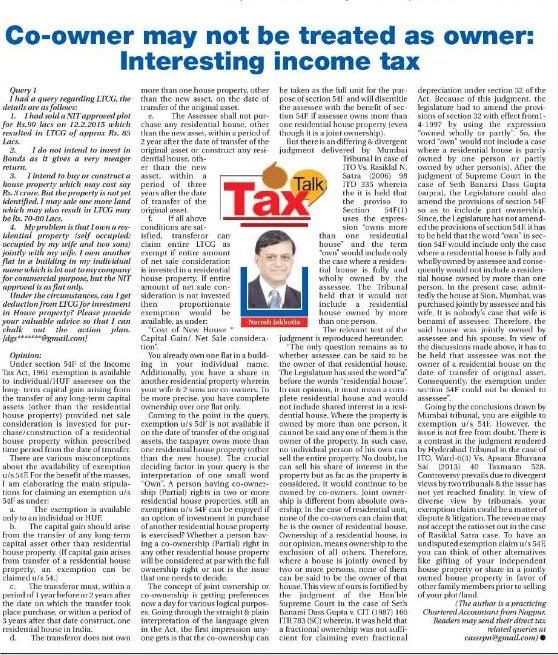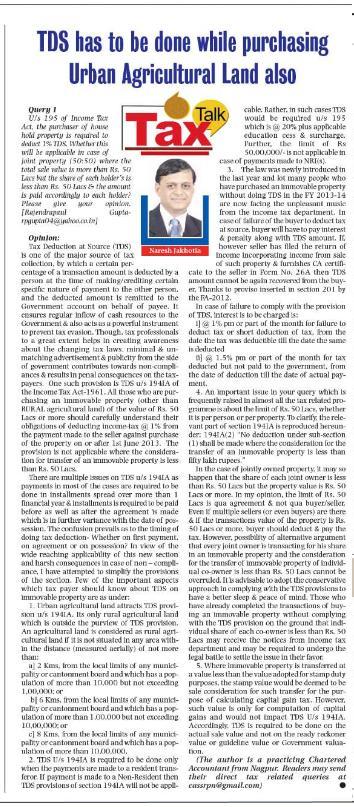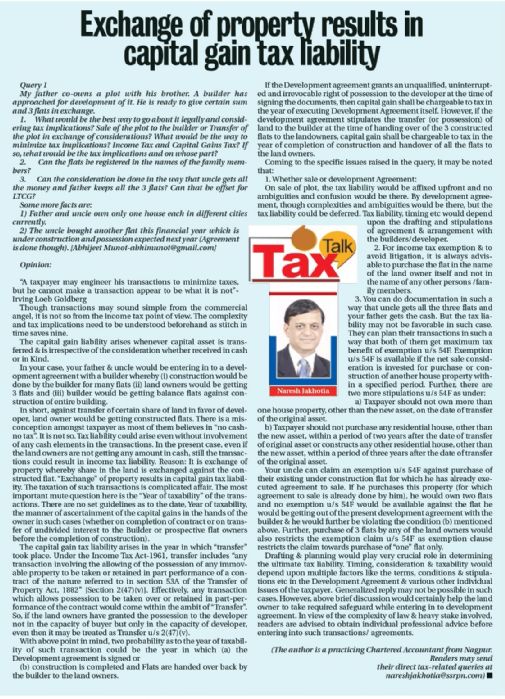Article Details
| Avail additional tax bonanza by investing Rs. 50,000/- in National Pension Scheme (NPS) |
|
Avail the Tax Bonanza by investing Rs. 50,000/- in NPS
One of the biggest tax saving bonanza by the Finance Act-2015 was insertion of sub-section 1B to section 80CCD in the Income Tax Act-1961 whereby an additional deduction of Rs. 50,000/- is offered to the taxpayer for contribution in the National Pension Scheme (NPS). The good news is that this deduction is over and above the deduction of Rs. 1.50 Lacs available u/s 80C for contribution in LIC/PPF/NSC etc. Deduction of Rs 50,000/- under 80CCD (1B) is exclusively for investments in NPS and cannot be availed against any other investment. With a view to promote social security measures and to provide the citizens with pension support, National Pension scheme was originally introduced for the Government employees long back in 2004. The scope of scheme was later on extended in 2009 so as to cover the private sector employee. And now, the benefit of the scheme has been extended so as to include self employed citizens also. Being a new product, many taxpayers are not aware of NPS as a tax saving tool. NPS is a voluntary pension scheme regulated by Pension Fund Regulatory and Development Authority (PFRDA). Any citizens of India between 18 - 60 years of age, whether resident or non-resident, are eligible to subscribe NPS. With fund management charge of mere 0.25% p.a., NPS is cheapest market linked online financial product. Being a low cost portable & transparent pension system, it has been able to garner Rs. 90,327 Crore from 1.15 Crore subscribers till January-2016. With the financial year drawing to a close, the interest has got even stronger. Tax Benefit: Tax benefit is one of the key consideration for arriving at an investment decision. The tax benefits of NPS are as under:
Investment & Return from NPS: The NPS funds are invested in the three broad categories - Equity (mainly Nifty stocks), corporate debt and government securities. Depending upon the risk appetite, an individual have option to choose from multiple fund manager and multiple investment options. The returns are market-linked and no fixed assurance is there. The money invested goes to the NPS fund manager who invests the money as per the choice opted by the taxpayer. The amount remains invested till the investor retires or opts out of the scheme. Private sector investor have the choice of 6 fund manager and are also allowed to port from one manager to another, giving them the option of choosing the best fund manager. Unlike ELSS, it is not that entire money is invested in equities by the fund manager. PFRDA has put strict cap on the amount that can be invested in equities. For Government Sector subscribers, the cap on equity investments is 15%. For other subscribers (all citizens model), the cap on equity investments is 50%. NPS doesn’t offer Pensions: Contrary to the name, NPS doesn’t provide regular pension but merely helps in accumulating the wealth. The accumulated wealth (or fund) then can be used to purchase annuity plan / pension plan from an insurance company. At the time of retirement, it is mandatory to purchase an annuity plan up to at least 40% of the accumulated amount. NPS, indirectly provides the pension to the citizens. The scheme is structured into two tiers: Tier-I and Tier II accounts. The Tier-I account is the non-withdrawable account meant for savings for retirement. Tier II account is a voluntary saving account. Taxpayer should carefully note that its only Tier 1 account of NPS that offers tax deductions & not the Tier 2. Negative side of NPS:
How to invest: Since negligible payout structure, it is not very well marketed by intermediaries. So, one may be required to invest in the NPS directly. As a first step, you need to register yourself with the NPS. Get an application form Point of Presence-Service Provider (POPSP) or download it from the NSDL website www.npscra.nsdl.co.in. Fill up the form and submit it at any nodal office of a POP-SP. One has to submit copies of proof of identity and residence (passport, Aadhar card, ration card, voter ID, driving license, utility bills, etc) along with the application form. Carry the original document for verification by the POP-SP. Even easy online application can also be done if your mobile number is linked to your Aadhar card. Just log on to the NSDL website www.enps.nsdl.com, punch the Aadhar number and after receiving & validating one time password (OTP), the investor's details and photo are automatically filled up in the online form. Investor has to upload a scanned signature and a photograph if he doesn't want the Aadhar picture. After uploading the form, the screen would be routed to a payment gateway for the initial contribution in the NPS account. The minimum amount is Rs 500. It can be paid by debit or credit card or Internet banking. PRAN card: After making the payment, a Permanent Retirement Account Number (PRAN) will be allotted to the subscribers & a welcome kit from the PFRDA containing a PRAN card, IPIN, TPIN and scheme details is also forwarded. Choosing a pension fund In the form, you will have to mention the pension fund you want to invest in. There are seven pension funds available to investors in the general category. An investor can switch to another pension fund only once in a year so choose very carefully. Go for a fund house that has consistently done well in the asset class you want to invest in. Asset mix: Investor have the option to actively decide as to how your NPS contribution is to be invested amongst the following three options: a] Asset Class E - Investments in predominantly equity market instruments. (Not more than 50% is allowed for investment in equity). b] Asset Class C - Investments in fixed income instruments other than Government securities. c] Asset Class G - Investments in Government securities. NPS offers an easy option for those investor who do not have the required knowledge to manage their NPS investment in the form of “Auto choice” option. In this option, asset allocation here depends on the age of the investor. Till the age of 35 years, 50% of his corpus will be in the equity funds and the rest in corporate debt and gilts. Every year, 2% of the assets in the equity fund and 1% of the assets in corporate bonds will be shifted to the gilt fund. In five years, by the time he is 40, the equity exposure of his NPS corpus would be down to 40%. By the time he is 55, he would have only 10% in equities, 10% in bonds and 80% in gilts. Withdrawal options: Amount from Tier I account can be withdrawn only on exit from NPS. Exit from NPS can be done at any point of time. The payout would be made to Subscriber as under: a] Withdrawal before the age 60 years: Up to 20% of Corpus can be withdrawn in lump sum, Minimum 80% of the Corpus needs to be invested in Annuity b] Withdrawal on attaining the age 60 years: Up to 60% of Corpus can be withdrawn in lump sum, Minimum 40% of the Corpus needs to be invested in Annuity Deferment options (applicable only for exit from NPS at age 60 years): a] Subscriber can defer the lump sum withdrawal for up to 10 years b] Subscriber can defer the annuity purchase for up to 3 years Death Benefit: On death of the Subscriber, Nominee / Legal heir can claim the entire Corpus. Annuity Service Providers: On exit from NPS, certain portion of amount has to be invested in Annuity. At present, below mentioned 7 life insurance companies are registered with PFRDA to offer annuity plans to NPS Subscribers: 1] HDFC Pension Management Company Ltd. 2] LIC Pension Fund Ltd. 3] ICICI Prudential Pension Funds Management Company Ltd. 4] Kotak Mahindra Pension Fund Ltd. 5] Reliance Capital Pension Fund Ltd. 6] SBI Pension Funds Private Ltd. 7] UTI Retirement Solutions Ltd. NPS, as a product, is still evolving. With limited withdrawal allowed before retirement, NPS is a true retirement product. [Author is a practicing chartered accountant & partner in SSRPN & CO, Nagpur. Readers may forward queries/feedback at cassrpn@gmail.com] |
 |




.png)




